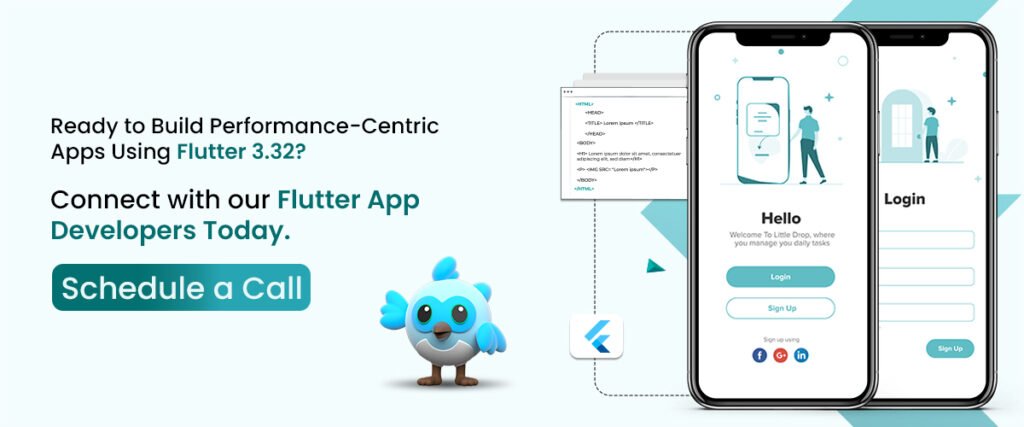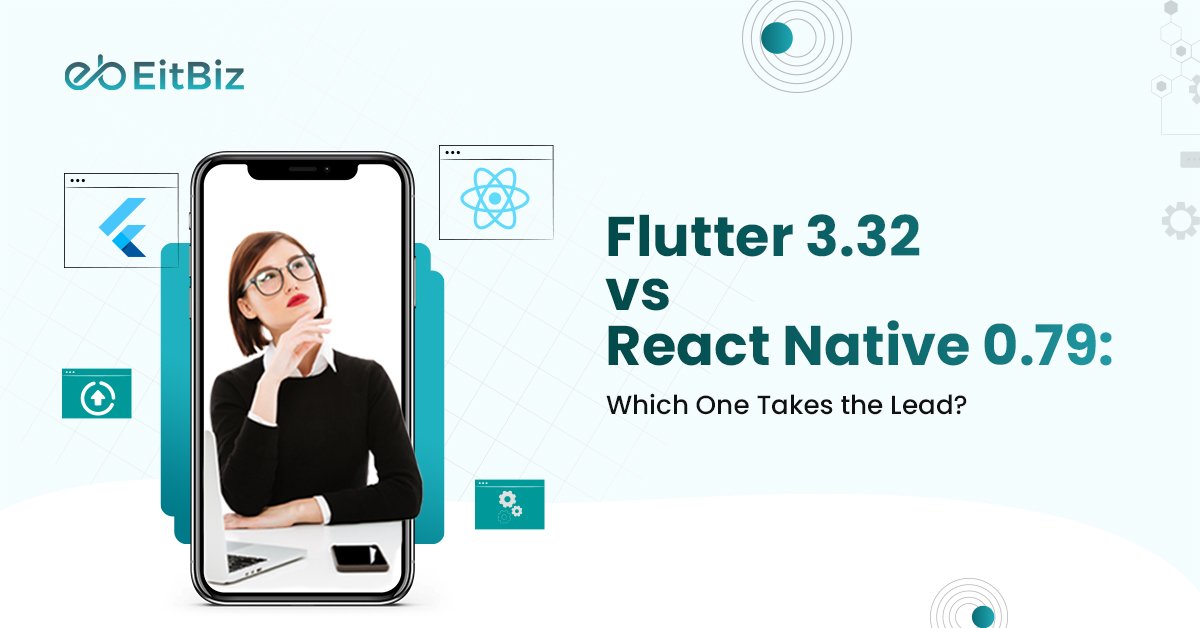The moment we talk about “mobile app development”, two popular frameworks strike the doors of our mind- “Flutter” & “React Native”!
Both are bitter rivals rather than friends in the realm of mobile app development!
Since their new versions have been launched, the battle has now become tougher, and it’s time to choose the winner in the Flutter vs. React Native debate.
Here are the two new launches- “Flutter 3.32” and “React Native 0.79”!
Let’s decode both of them and find out which is the ideal mobile app development framework in 2025!
What’s New in Flutter?
Released in May, Flutter 3.32.0 is the latest stable release of Google’s open-source UI toolkit, designed for building high-performance, natively compiled applications for mobile, web, desktop, and embedded platforms from a single codebase.
Built using the Dart programming language, Flutter 3.32.0 is all about cross-platform development to deliver enhanced performance, improved rendering, and more refined support for Material 3 design principles. Furthermore, developers also benefit from expanded support for iOS and Android-specific APIs, updated widgets, and stability improvements.
With Flutter’s latest version, Google reinforces its commitment to developer productivity, user interface consistency, and support for modern design trends, which makes flutter an ideal choice for teams building apps that scale across multiple devices.
What are the New Features of Flutter 3.32 Update?
Though the latest update is all set to bring some exciting features, it’s time to take a look at some.
Feature #1: Enhanced Performance
One of the biggest highlights of Flutter 3.32 is that it uses the “Impeller Rendering Engine,” which can significantly boost the app’s performance to the fullest. No matter whether you want to build Android or iOS apps, it not only enhances performance but also smoothens animations.
Feature #2: Modern Theme System
Another major key feature of Flutter 3.32 is that it allows developers to have complete control over “Material Theme Data” and override indicators via “TabBarTheme.indicatorColor”. Thus, it ultimately helps maintain the UI’s consistency without running into complex customization.
Feature #3: Plugin & Build System Enhancements
Gone are the days when .flutter-plugins were used. With the new Flutter update, plugins now use. flutter-plugins-dependencies, which may provide more transparent dependency management. Furthermore, the new localization behavior effectively eliminates the need for synthetic packages to reduce build complexity.
Though Flutter has already made significant improvements with its upgrade, it’s time to set our sights on the next contender, i.e., React Native

Now, what is React Native 0.79?
React Native 0.79 is the latest version of Meta’s open-source framework for building mobile applications using JavaScript and React. It allows developers to create cross-platform apps for iOS and Android with a shared codebase, while still delivering a near-native user experience. With version 0.79, React Native continues to streamline development by improving performance, reducing build times, and enhancing compatibility with the latest native modules.
React Native 0.79 also lays the groundwork for better developer experience with simplified APIs, updated libraries, and improved error handling. Whether you’re building a small app or a large-scale product, React Native 0.79 gives you the tools to move faster without sacrificing quality or performance.
What are the Key Features of React Native 0.79?
1. Improved Hermes Engine Integration
React Native 0.79 enhances its default JavaScript engine, Hermes, with better performance and memory efficiency. Hermes now supports more modern JavaScript features and delivers faster app startup times, reduced bundle sizes, and smoother execution—especially on low-end devices. This makes your app feel more responsive and lightweight right out of the box.
2. Enhanced Compatibility with Native Modules
This version brings improved support for native modules, allowing developers to integrate native iOS and Android code more easily. With more stable bridges and better type safety (thanks to TypeScript and Flow improvements), building custom native features or using third-party SDKs is now more reliable and maintainable.
3. Modernized Android and iOS Tooling
React Native 0.79 updates its compatibility with the latest versions of Android Studio and Xcode. It includes support for newer SDKs (such as Android API 34) and the latest iOS deployment targets, ensuring that apps remain compliant with platform requirements. This makes it easier for developers to publish and maintain apps in app stores without facing build or compatibility issues.
4. Simplified TurboModules & Fabric Integration (Experimental)
While still evolving, TurboModules and Fabric—React Native’s new rendering and native interaction architectures—are better supported in 0.79. These systems aim to improve UI performance and memory usage by reducing overhead between JavaScript and native code. Developers can start experimenting with these for smoother animations and faster interactions.
5. Better Developer Experience & Debugging Tools
React Native 0.79 brings a smoother developer experience with improved error messaging, better CLI tools, and tighter integration with debugging platforms like Flipper. Enhanced Metro bundler performance and faster reload times help developers iterate faster during development.
Flutter 3.32 vs React Native 0.79: Which is the Best Framework in 2025?
Flutter 3.32 and React Native 0.79 both bring powerful cross-platform capabilities to the table in 2025, but each caters to different development needs. Flutter 3.32 stands out with its consistent UI rendering across platforms, faster performance due to native compilation with Dart, and rich support for Material 3 design. It’s ideal for teams seeking pixel-perfect control and a unified development experience across mobile, web, and desktop. On the other hand, React Native 0.79 shines with improved Hermes engine performance, better native module integration, and stronger alignment with JavaScript and the broader React ecosystem.
Speaking of the ultimate winner, Flutter leads in UI consistency and multi-platform reach. At the same time, React Native offers flexibility and easier onboarding for JavaScript developers, making the “best” choice dependent on your team’s goals, skill set, and project scope. Ready to leverage Flutter or React Native for mobile app development? If so, contact us at info@eitbiz.com today!





